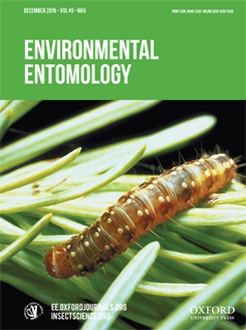Wheat stem sawfly (Cephus cinctus Norton, Hymenoptera: Cephidae) has long been a significant insect pest of spring, and more recently, winter wheat in the northern Great Plains. Wheat stem sawfly was first observed infesting winter wheat in Colorado in 2010 and, subsequently, has spread rapidly throughout wheat production regions of the state. Here, we used maximum entropy modeling (MaxEnt) to generate habitat suitability maps in order to predict the risk of crop damage as this species spreads throughout the winter wheat-growing regions of Colorado. We identified environmental variables that influence the current distribution of wheat stem sawfly in the state and evaluated whether remotely sensed variables improved model performance. We used presence localities of C. cinctus and climatic, topographic, soils, and normalized difference vegetation index and enhanced vegetation index data derived from Moderate Resolution Imaging Spectroradiometer (MODIS) imagery as environmental variables. All models had high performance in that they were successful in predicting suitable habitat for C. cinctus in its current distribution in eastern Colorado. The enhanced vegetation index for the month of April improved model performance and was identified as a top contributor to MaxEnt model. Soil clay percent at 0–5 cm, temperature seasonality, and precipitation seasonality were also associated with C. cinctus distribution in Colorado. The improved model performance resulting from integrating vegetation indices in our study demonstrates the ability of remote sensing technologies to enhance species distribution modeling. These risk maps generated can assist managers in planning control measures for current infestations and assess the future risk of C. cinctus establishment in currently uninfested regions.
BioOne.org will be down briefly for maintenance on 17 December 2024 between 18:00-22:00 Pacific Time US. We apologize for any inconvenience.
How to translate text using browser tools
22 September 2016
MODIS Imagery Improves Pest Risk Assessment: A Case Study of Wheat Stem Sawfly (Cephus cinctus, Hymenoptera: Cephidae) in Colorado, USA
Jordan Lestina,
Maxwell Cook,
Sunil Kumar,
Jeffrey Morisette,
Paul J. Ode,
Frank Peairs
ACCESS THE FULL ARTICLE
It is not available for individual sale.
This article is only available to subscribers.
It is not available for individual sale.
It is not available for individual sale.

Environmental Entomology
Vol. 45 • No. 6
December 2016
Vol. 45 • No. 6
December 2016
Cephus cinctus
enhanced vegetation index
MaxEnt
presence-only modeling
wheat stem sawfly




